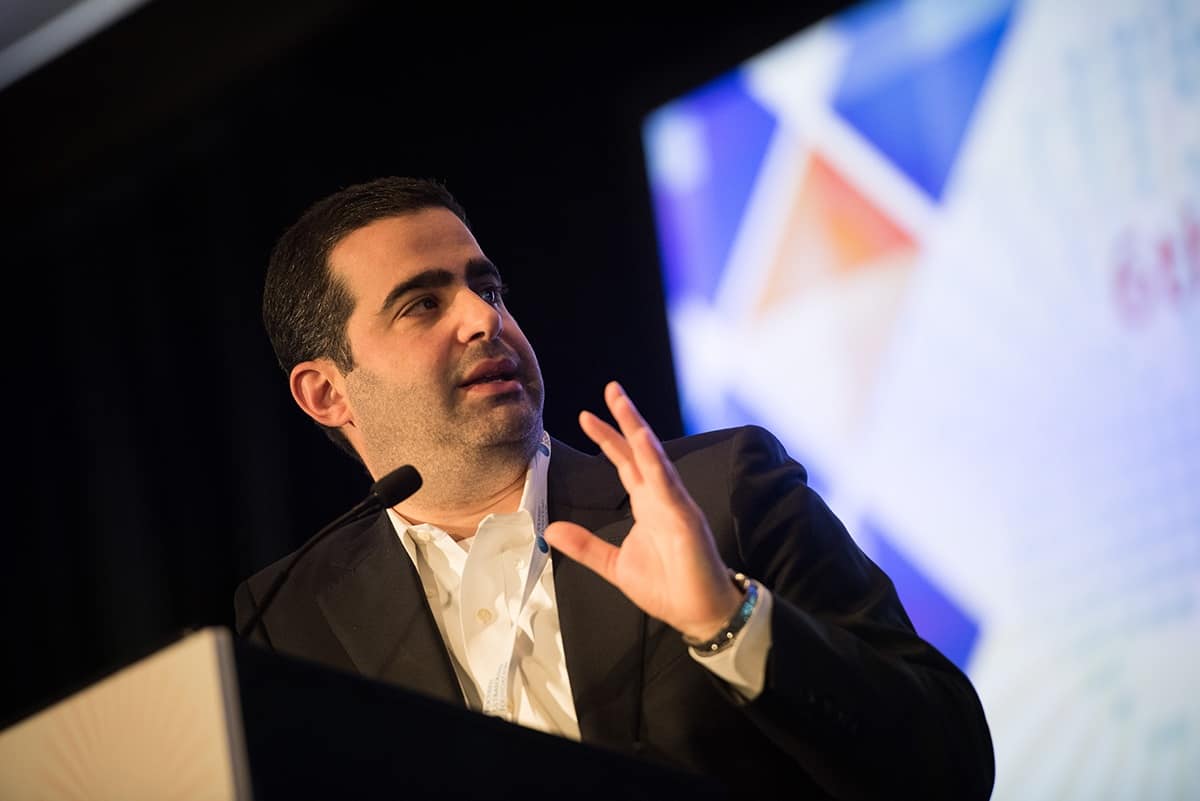
“Focused ultrasound is the most powerful sound you will never hear — but it could someday save your life,” said Neal Kassell, speaking at last week’s 6th International Symposium on Focused Ultrasound.
An early-stage, non-invasive therapy, focused ultrasound works by focusing multiple beams of ultrasound onto targets deep within the body with a high degree of accuracy. In doing so, the focused sonic energy can destroy targeted cells while sparing adjacent normal tissue. But that’s not all it can do – as well as ablating tumours or other disease targets, focused ultrasound can be used to stimulate an immune response, open the blood–brain barrier (BBB) and much more.
Kassell, chairman of the Focused Ultrasound Foundation, explained that at the point where the ultrasound beams converge, a wide array of biological mechanisms can occur, creating an opportunity to treat an enormous variety of serious medical conditions. “Today, [treatments for] over 100 medical disorders are in various stages of development. Ten years ago, there were only three,” he said.
“Focused ultrasound has the potential to transform the treatment of a whole variety of serious medical disorders, and thereby impact the lives of millions of people around the world,” said Kassell.
“But there’s an enormous amount of work that remains to be done before focused ultrasound can achieve its potential.”
BBB opening
One exciting emerging application is the use of focused ultrasound to enhance drug delivery to the brain. The brain is protected by the BBB, which contains tight junctions that prevent passive diffusion of molecules from the blood into the brain.

“This is great for protecting the brain, but it’s also a big problem if we want to develop and use drugs in the brain,” explained Nathan McDannold, a physicist at Brigham & Women’s Hospital. “More than 98% of small molecules and practically all large-molecule drugs do not cross the BBB and cannot be used effectively in the brain.”
Application of focused ultrasound has been shown to cause increased permeability in the blood vessels in the brain. This effect is attributed to the presence of microbubbles, which expand and contract in response to the ultrasound. “If we inject microbubbles before ultrasound, we can concentrate the acoustic effects on the blood vessels in a gentle way,” McDannold said. “This results in an opening of tight junctions and an increase in active transport.
McDannold shared some examples of his group’s preclinical work. In one example, the team disrupted the BBB in and around the tumour in a rat brain. The aim was to enhance the amount of drug reaching the tumour, as well as to target infiltrating cells in the tumour periphery. He also showed a mouse model of Alzheimer’s disease, where the researchers injected an agent that targets amyloid-beta plaque, a hallmark of Alzheimer’s, following BBB disruption. Imaging revealed the plaque location and demonstrated the possibility of administering drugs to amyloid-beta plaques.
Concluding his presentation, McDannold updated on the current status of this field. He noted that BBB disruption is a reversible effect: the BBB can be opened for a few hours and then closes exponentially with a half-life of one to six hours.
“We’ve shown that it is safe – ultrasound can be applied repeatedly without significant pathology or any functional deficits,” he explained. “We can control where the barrier is opened, to direct the delivery of drugs only to areas that we want, and can also use feedback via acoustic monitoring to potentially control the level of opening.”
He noted that the approach is “drug-neutral”: following BBB disruption it’s possible to deliver therapeutics including small molecules, nanoparticles, liposomes and even stem cells. Finally, McDannold highlighted that BBB opening can be clinically translated, and that human trials are now underway.
Clinical translation
“We are working on trying to open the blood–brain barrier in various clinical trials,” said Nir Lipsman, a neurosurgeon at Sunnybrook Health Sciences Centre. He pointed out that current research is very much a concerted effort, with labs and institutes worldwide investigating focused ultrasound-induced BBB opening.

“There may be effective agents for many neurodegenerative and other brain disorders, but we just can’t get enough drug into the brain to have a meaningful impact,” Lipsman explained. “A safe and reversible means of opening the BBB directly at the site of pathology has been a major goal for several decades.” He then presented a “greatest hits” of BBB studies happening around the world.
One key area of investigation is treatment of glioblastoma (GBM), the most aggressive brain tumour. Lipsman and his team launched a proof-of-concept trial using the Exablate system to open the BBB after GBM resection, under real-time MRI guidance. The aim is to enhance delivery of chemotherapeutics to the rim around the resected tumour where 98% of recurrences occur. “We performed a small trial in five patients to demonstrate that it is safe to open the BBB,” he said. “We managed to do that with no adverse effects.”
Elsewhere, a team in Taiwan led by Arthur Lung is using the NaviFUS system for transient BBB opening in patients with recurrent GBM. NaviFUS is a different type of device that utilizes intraoperative neuro-navigation guidance and CT-based treatment planning. In August of this year, the researchers treated two patients and demonstrated successful BBB opening.
And in France, Alexandre Carpentier and colleagues are investigating low-intensity ultrasound for transient BBB opening, again looking at recurrent GBM. The team has used the SonoCloud implantable transducer in 19 patients to date, with results that indicate the procedure is safe and may influence overall survival.
“Multiple centres around the world are using different technologies to achieve this,” Lipsman emphasized.
Beyond cancer treatments
BBB opening could also help deliver therapeutics to the brains of Parkinson’s disease patients.
“There’s been tremendous interest in trying to deliver growth factors to the brain, but so far, human trials using direct delivery have failed, likely because not enough got in,” said Lipsman.
He described a preclinical trial of focused ultrasound-mediated BBB opening, in which Richard Price and colleagues demonstrated significant delivery of the GDNF gene into the brains of rats. Importantly, this gene delivery also led to a change in the animals’ behaviours.
Elsewhere, Hairong Zhang and colleagues are studying BBB opening for delivery of antibodies to alpha synuclein, a protein that occurs in patients with Parkinson’s disease. They used sonication to open the BBB in 10 mice, and concurrently delivered the antibody. This resulted in enhanced antibody delivery, reduction of alpha synuclein levels and a change in the animals’ symptoms.
Lipsman pointed out that this antibody is several hundred times larger than a typical compound that can cross the BBB. “If this can get across, then you can cross virtually any compound that you want to deliver,” he said. “The hope is that this is translatable to humans.”
Another condition that could potentially benefit from BBB opening is Alzheimer’s disease. Motivated by preclinical data suggesting that opening the BBB may help clear amyloid-beta plaque, Lipsman and colleagues investigated this approach in a small trial. “We managed to safely, repeatably and reversibly open the BBB in six patients with mild to moderate Alzheimer’s disease,” he said, noting that larger trials are ongoing.
Finally, Lipsman described BBB opening after ischemic stroke, for intra-arterial delivery of mitochondria. “Even in conditions that we previously thought we really could not touch, such as stroke, focused ultrasound may play a profound role in delivering healthy things to the brain,” he said.
“It’s early days, but there’s intense interest in improving every aspect of the BBB opening process, both the hardware and software,” Lipsman concluded. “And as we work on the focused ultrasound, other groups of scientists are working to develop novel treatments to deliver to the brain.”



